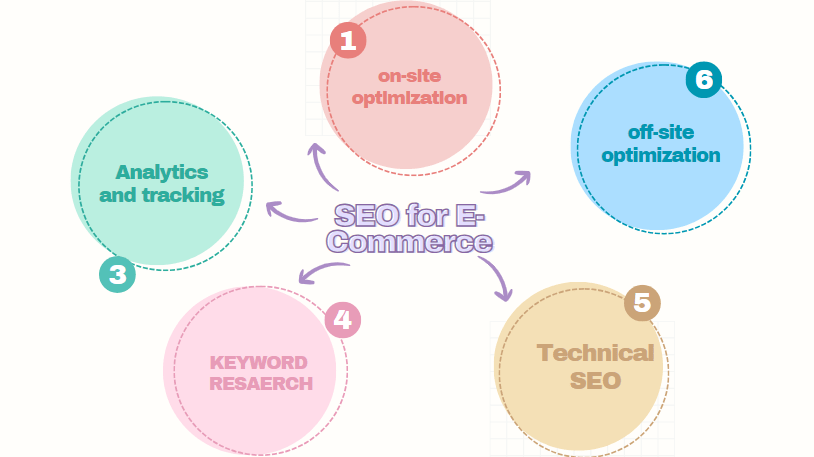In the fiercely competitive e-commerce space, becoming an expert in SEO techniques is essential for success. These strategies, which include meticulous keyword research, product page optimization, and structured data markup, are designed to increase visibility, attract relevant traffic, and drive conversions. This guide will review the fundamental SEO techniques specific to e-commerce websites, allowing you to improve your online store’s visibility and achieve long-term growth in the digital marketplace. Join us as we navigate the ever-changing e-commerce SEO landscape to help your online business reach its full potential.
E-commerce for SEO practices :
E-commerce SEO practices are tailored strategies to boost online store visibility and attract potential customers. Critical practices include:
Utilizing structured data markup for rich snippets, generating high-quality content such as product guides or blogs, and actively managing online reviews also improve search rankings and customer trust. By consistently implementing these practices, e-commerce websites can effectively compete in search engine results, driving organic traffic and increasing conversions.
What Is SEO for E-Commerce?

SEO for e-commerce entails making online stores appear higher in search engine rankings, drawing in more possible clients. This includes conducting keyword research, optimizing product pages with relevant keywords and compelling meta tags, and ensuring technical aspects like site speed and mobile friendliness. Additionally, user experience optimization, content marketing, and the creation of high-quality backlinks are critical for success. The goal is to improve visibility, drive organic traffic, and increase e-commerce sales and revenue.
The most effective e-commerce SEO strategies include:
Additionally, implementing structured data markup for rich snippets, generating high-quality content such as product guides or blogs, and actively managing online reviews are crucial. Building authoritative backlinks and optimizing for local search are also effective strategies for increasing organic traffic and conversions.
Overall, e-commerce SEO success requires a comprehensive approach that includes technical optimization, content marketing, and user experience enhancements.
1. Comprehensive Keyword Research :
Comprehensive keyword research is vital for e-commerce SEO. It involves identifying relevant search terms using tools like Google Keyword Planner. Targeting high-volume keywords with manageable competition enhances visibility and attracts potential customers. Regular updates ensure continued relevance and effectiveness.
2. Optimized Product Pages :
Optimized product pages are critical for e-commerce SEO. Incorporating relevant keywords seamlessly into titles, descriptions, and meta tags improves search engine visibility. Engaging and informative product descriptions are crucial for capturing users and improving search rankings. Visual appeal is essential; high-quality images and videos effectively promote products. For a smooth shopping experience, intuitive navigation and clear calls to action are crucial. Mobile optimization is necessary for catering to on-the-go customers. Finally, focusing on conversion-driving elements like pricing, discounts, and product reviews increases the likelihood of conversions.
3. Mobile Optimization :
Mobile optimization is critical to e-commerce SEO. A responsive design allows websites to adjust to various screen sizes and gadgets effortlessly, leading to a consistent user experience. Fast loading times are critical for retaining mobile users, and this is accomplished through image optimization and code minimization. Simplifying navigation menus and including tappable buttons improves mobile usability. Additionally, optimizing content for voice search and implementing location-based strategies address the growing number of mobile users. Utilizing innovations like Accelerated Mobile Pages (AMP) enhances mobile experience and SEO performance. Pricing, discounts, and product reviews all increase the likelihood of conversions.
4. High-Quality Content Creation :
High-quality content creation is critical to SEO success. It entails creating relevant, original content that engages the target audience while incorporating strategic keyword optimization. Using multimedia elements like images and videos enhances the content and increases user engagement. Consistent publishing schedules boost audience engagement and demonstrate expertise in the field. Finally, prioritizing high-quality content creation boosts the website’s authority, organic traffic, and search engine rankings.
5. User-Generated Content :
User-generated content (UGC) is a critical component of successful SEO strategies. It includes genuine insights, reviews, and user-shared experiences, which increase credibility and trust. UGC encourages active participation, which increases audience engagement and loyalty. From an SEO standpoint, UGC frequently contains valuable keywords and natural language, which improves search engine visibility and rankings. Furthermore, positive UGC is powerful social proof, influencing potential customers’ purchasing decisions. Embracing user-generated content broadens content offerings and fosters community, strengthening brand relationships and sustainable growth.
These are the most effective e-commerce SEO strategies involved in SEO techniques for growing e-commerce websites.
E-commerce website SEO:
Conduct keyword research to target relevant terms and optimize product pages with keywords in titles, descriptions, and URLs. Create a clear site structure for easy navigation, and use internal linking to distribute link equity. Optimize your images with descriptive filenames and alt text. Performance should be monitored regularly to ensure continuous improvement, and strategies should be adjusted as necessary.
E-commerce Website SEO plays a critical role in the success of online businesses. Increase your website’s presence in search results by making it more visible. Results by improving its visibility, attracting more qualified traffic, and increasing sales. SEO ensures potential customers can easily find your products by conducting targeted keyword research, optimizing on-page content, and improving user experience. In today’s competitive online landscape, a well-executed SEO strategy gives e-commerce businesses a significant competitive advantage, resulting in long-term growth and success.
Conclusion :
Implementing effective SEO techniques for e-commerce websites is critical to online success. Businesses can dramatically improve their search engine visibility by optimizing product pages, conducting extensive keyword research, and improving site structure and navigation. This increased visibility generates more organic traffic, increased conversion rates, and improved customer experience and sales. In today’s competitive online marketplace, investing in SEO is beneficial and required for e-commerce businesses to thrive and stay ahead.
Frequently asked questions :
1.What are the key SEO techniques for optimizing e-commerce websites?
Developing product pages with relevant keywords, original descriptions, and optimized images are essential SEO strategies for e-commerce websites. Both crawlability and user experience are improved by optimizing the site’s internal linking, navigation, and structure. Optimizing page speed and mobile responsiveness guarantees optimal performance, while using schema markup and obtaining high-quality backlinks further increases search engine visibility.
2.What are the best practices for on-page SEO optimization for e-commerce product pages?
The process of on-page SEO optimization for e-commerce product pages entails creating original titles and meta descriptions that contain appropriate keywords. Adding descriptive alt text to high-quality images improves indexing and user experience. Search engine visibility is improved by using schema markup and making sure URLs are user-friendly. Setting mobile friendliness and page load speed as top priorities increases user engagement and search engine rankings. When combined, these tactics enhance e-commerce websites’ search engine ranking and visibility.
3.How do I optimize product descriptions and metadata to enhance SEO for e-commerce?
Enhancing metadata and product descriptions for online sales Writing engaging descriptions, using structured data markup, and creating descriptive titles and meta descriptions with keywords are all part of SEO. Search engine rankings are also improved by making alt text and picture filenames as accessible and consistent as possible across all metadata and descriptions.
4.What role does site structure play in e-commerce SEO, and how can it be optimized?
Site structure is essential in e-commerce SEO as it affects crawlability, user experience, and indexing. Optimizing it involves creating a logical hierarchy with clear categories, subcategories, and internal linking. Utilizing breadcrumbs, XML sitemaps, and navigation menus enhances both user experience and search engine crawling. Additionally, minimizing duplicate content and ensuring mobile responsiveness are crucial aspects of optimizing e-commerce site structure for SEO.
5.What strategies can I employ for optimizing e-commerce website speed and performance for SEO?
Implement lazy loading and image compression to improve e-commerce website performance and speed for search engines. Combining CSS and JavaScript files will reduce the amount of HTTP requests made; additionally, browser caching can be enabled. Employ Accelerated Mobile Pages (AMP) for mobile optimization and Content Delivery Networks (CDNs) for worldwide content distribution. Optimizing database queries and server response times is possible with regular performance metrics monitoring.

